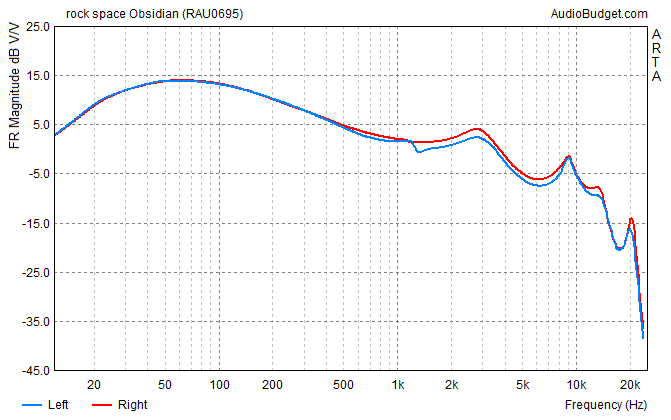rock space Obsidian (RAU0695)
ø10mm Dynamic Driver
Seems like the renown ROCK Zircon have reached end-of-life, and the new Obsidian are supposed to be the successor. Are they worthy of filling those big ceramic shoes? Yes, but not entirely.
Despite both sharing a ceramic housing and somewhat related aesthetics, these are two different earphones with vaguely the same target audience in mind. This time ROCK, or should we say - rock space, have opted for a more balanced and tolerable sound signature, in place of the obviously V-shaped sound signature of the Zircon.
Both are bassy earphones, and while the Zircon obviously have the beefier lows, the Obsidian offer a calmer bass, but also a cleaner approach to both the mids and the highs, resulting in a less edgy, more pleasant and natural sound.
So if you aim for bass, the Obsidian can still fit your needs, but don't expect the same eardrum-shaking experience, and the I-INTO i8 could be your only good-sounding alternative at this point. However, if you want excellent bass along with relaxed mids and highs, the Obsidian is the right choice at this price point.
Another thing to mention is the fact that ROCK finally realized that using an unprotected angled plug is a bad idea, and opted for a simpler straight plug with a proper strain relief.
To put it short, Obsidian has clearly won my respect and it is one of my top picks in that price range, as I learned to appreciate their sound when compared head-to-head with the budget veteran - the ROCK Zircon, but don't expect them to win when it comes to pricier options.
Sound signature: Balanced (with extra bass)
Buy on 
Pros
- An upgrade in sound precision and clarity over the predecessor, the Zircon.
- Much more tolerable sound signature over the predecessor, with relaxed bass along with reduced peaks in treble for a more neutral sound.
- Impressive base depth and stability.
- Yet another shiny ceramic earphones from the house of ROCK, always a pleasure.
- The plug shows more promise when it comes to durability, comparably speaking.
Cons
- Bassheads looking for a Zircon alternative might be disappointed by the somewhat toned-down bass response.
- Fit can be tricky for some users, especially with the mediocre included ear tips.
Ear Tips - Single-Flange:
S+M+L, grey (translucent), ø4.5mm black bores
Housings*:
Ceramic + metal*, ø4.5mm nozzles, no strain reliefs
Cable:
Fabric + TPE, 121cm, extra-soft, straight
Plug:
Metal, straight, short, soft strain relief
- The housings have no channel markings. The inline remote's side is the right channel.
- The housings have metal nozzles.
Sure, the Obsidian utilize an interesting design, but I wouldn't say that it's an optimal one. I found these earphones quite tricky to fit properly in the advertised cable-straight-down fashion, especially with the included ear tips. In fact, I found it much easier to get a tight seal if I wear them over-the-ear, despite the housings aren't quite designed for that. Speaking of the ear tips, the included ones aren't great, quite basic and not the most grippy I've used. Definitely a downgrade from the legendary Zircon tips.
Let's just go ahead and say it - these are not ROCK Zircon, and can't replace them when it comes to bass. The Zircon pushed the boundaries when it comes to how deep of a bass single-dynamic-driver budget earphones can output, but sacrificed stability at the extreme low frequencies. Meanwhile, the Obsidian opted for a more relaxed, yet still impressively deep bass, with the main advantage of having a lot more stability with as little distortion as possible, on any tolerable volume level. That been said, don't expect the same amount of sub-bass rumble as you might remember having with the Zircon. Still, I think they've done an excellent job and perhaps the right choice.
We can't ignore the real improvements of the Obsidian over the predecessor, the main aspect being the mids. They are just so much cleaner and precise. Sure, don't expect some high-grade dynamic driver or balanced armature precision, but for that price point? I'd say we have a winner. The overall tonality is substantially more accurate, voices are more true-to-life, and instruments are more realistic-sounding. Even the upper-mids, which were rather over-the-top on the Zircon, are flatter and more natural on the Obsidian. Placing the mids a bit closer to the front could really make them shine, but overall - good job, truly.
Any Zircon owner should be able to point out the unashamedly sharp highs on those earphones, as a result of their V-shaped sound signature. Well, this is not the case with the Obsidian at all. The highs here are still quite crisp, bright and tonally accurate, but are relatively restrained in order to avoid shrillness and listening fatigue. When it comes to level of detail, it's more than enough for most users, but the enthusiasts among us might prefer something that sounds more analytical. Still, for their target audience and price point, this is quite an interesting and rare tuning.
Frequency Response
Published on 2020-11-04 22:27:12 (GMT)











